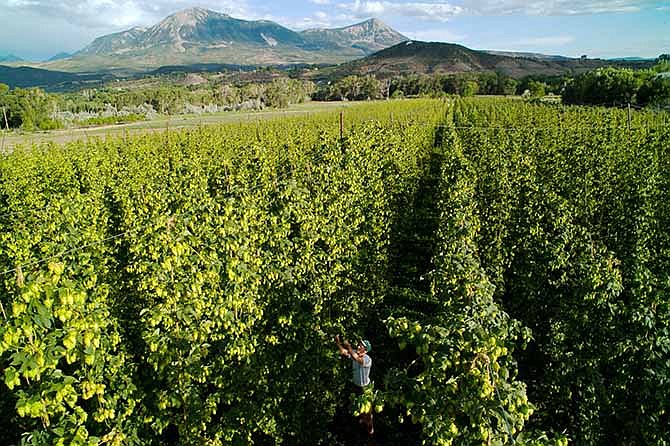MILWAUKEE (AP) - Craft brewers eager to capitalize on the local food movement have created a strong demand for hops to flavor their all-local beers, but farms in most states have grown slowly because of high investment costs and limited knowledge of the plants.
Hops prices ran high in 2008 after a drought and storm damage in Europe and a fire at a major warehouse in Washington state sparked fears of a shortage. Many farmers looking for a quick buck launched ventures to fill the void, only to go under.
Most who remain in business come from agricultural backgrounds and have eased into hops. The goal now seems to be slow-but-steady growth, even in areas where brewers are offering high-priced contracts or money to help start farms.
Paul Graham, president of Central Waters Brewing Co. in Wisconsin, remembers when his phone rang daily with would-be growers. He partnered with four other brewers in 2009 to provide a handful of farmers with seed money. More than four years later, the cooperative has only about six acres of hops in production. The entire state - known for its love of beer - has about 50 acres.
"The success that we've seen is mostly with some experienced farmers who are kind of diversifying or who have experience on a farm for a long time," Graham said. "A lot of the hobbyists who got into it right away, most of them are back out of it just because it's labor-intensive and you're not making much money."
Randy Flores started a farm in western Colorado in 2008 but gave it up two years later. He had banked on a partner's real estate commissions to provide capital to buy processing equipment, and the money fell through during the recession.
With a limited market and falling prices for unprocessed hops, Flores didn't see the farm making it. The 54-year-old Denver resident now has a business buying and selling hops to smaller brewers.
People were "romanced" into growing hops, Flores said, but "it's a hell of a lot of work for just a little bit of money."
It costs about $10,000 to buy rootstock and set up the trellis system required to grow hops vines. Farmers erect 16- to 20-foot poles connected by cables, from which they run strings to the ground for the plants to climb up. The cone-like flowers that grow atop the vines give beer its unique, bitter taste.
Equipment to pick, bale and dry hops costs tens of thousands of dollars more, putting the initial investment for a 10-acre farm at close to $250,000, said Ron Godin, a hops specialist with Colorado State University Extension.
Randy Urness and his wife conducted a "scavenger hunt" with Craigslist and newspaper ads to find old telephone poles and secondhand cable to build trellises on their farm in Rosholt, Wis. They planted 700 rhizomes, or rootstocks, on 1.5 acres in 2010 and have gradually built up to about 2,100 plants on three acres.
Urness said it will be years before his investment pays off, particularly since the plants take up to five years to reach full production.
"The last year has been, by far, a net loss," said Urness, 47. "Hopefully, after another year or two, we'll be able to say, 'OK, what we've put into it this year vs. what we've gotten out of it, we have made some profit and been able to cover loans and things of that nature."
Hops can be used fresh, or wet, but they spoil rapidly - the cones Graham buys are used within 24 hours of harvest. Most beer is made with hops that have been dried, crushed into a powder and formed into shelf-stable pellets that resemble rabbit food. One pound of dry hops is equivalent to four pounds of wet hops.
Making the jump from producing wet hops for single-batch beers to providing pellets for year-round brewing is the "major hurdle" most growers face, said Ryan Houghton, a 34-year-old software consultant from Portland, Maine, who has been building a hops farm with several partners.
A pelletizer can cost as much as $250,000. Wisconsin has at least three, but states like Colorado have none.
AC Golden Brewing Co., the Colorado-based craft arm of MillerCoors, has helped its 13 contract growers get around this problem by hauling dried cones to Washington state for processing before using them in its Colorado Native Lager. The brewer also pays $15 per pound for hops - well over the market rate - to help offset its farmers' startup costs.
But even with AC Golden's incentives and more than 100 other craft brewers eager to buy Colorado-grown hops, farmers have planted only about 75 acres there.
In New York, which has more than 140 craft breweries, farmers have planted about 150 acres and hope to increase to more than 250 by summer, said Steve Miller, a Cornell University Cooperative Extension hops specialist.
Another big challenge for those farmers is a lack of information.
Hops haven't been grown commercially outside the Pacific Northwest for more than 100 years, and knowledge of the plant died out in that time. Methods used to combat fungus, ward off pests and irrigate in arid parts of Washington state, with its 27,000 acres of hops, don't necessarily work in more humid climates, said Ryan Trzebiatowski, a 33-year-old engineer who has a small hops farm in Amherst, Wis.
In many cases, farmers don't even know how much they can grow per acre. Trzebiatowski harvested 3,000 wet pounds last year; his goal is 5,000. Some Western farms hit 10,000.
But one thing is clear - there's a "sex appeal" in hops that other crops don't have, Trzebiatowski said.
"People ask if I'm going to continue doing this, and my answer is yes," he said. "It's a fun project, it's not all consuming of my time, and it's a good conversation starter."

